An air flow meter is an essential component in automotive engines, responsible for measuring the volume of air entering the engine. Its primary function is to ensure the correct air-to-fuel ratio for efficient combustion and optimal engine performance.
The measurement process of an air flow meter involves various methods, with one of the most common being the use of a hot wire or hot film sensor. In this type of air flow meter, a thin wire or film is heated to a constant temperature, and as air flows over it, it cools down, causing a change in electrical resistance. This change in resistance is then converted into a voltage signal, which is proportional to the mass or volume of air passing through the meter.
Another type of air flow meter commonly used in automotive applications is the vane meter. This meter employs a spring-loaded vane that is deflected by the incoming air flow. The degree of deflection is measured electronically and translated into an air flow rate.
Additionally, there are also mass air flow meters that directly measure the mass of air entering the engine, providing more accurate readings compared to volumetric air flow meters. These mass air flow meters typically utilize a heated sensing element or a vibrating wire to measure the air mass directly.
Each type of air flow meter has its advantages and disadvantages in terms of accuracy, response time, and cost. Hot wire/film meters are known for their fast response time and compact size, while vane meters are relatively simple and robust. Mass air flow meters offer superior accuracy but are generally more expensive and complex.
In conclusion, air flow meters play a crucial role in automotive engines by accurately measuring the volume or mass of air entering the engine. Whether it's through hot wire/film sensors, vane meters, or mass air flow sensors, these devices ensure the proper air-to-fuel ratio for efficient combustion and optimal engine performance. With advancements in technology, air flow meters continue to evolve, providing engineers with more precise and reliable tools for engine management and performance optimization.

